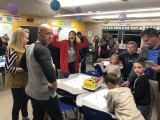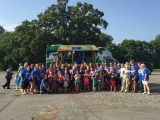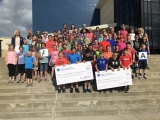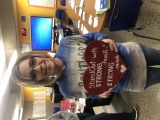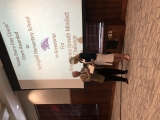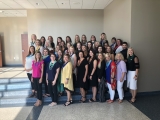-
Category 1
Selected in 2018
-
Grades: k - 5
School Setting: rural
Town Population: 5
Student Enrollment: 452
Student Demographics:
Black/African American: 0.4%
Teacher/Student Ratio: 1:22.3
White/Caucasian: 96.4%
Hispanic: 2%
Hawaiian/Pacific Islander: 0%
Asian: 0.2%
Native American: 0%
Other: 0.9%
% Reduced Lunch: 43%
% ELL Learners: 2%
Founded: 2016 -
PRINCIPAL:
Stephanie Worthey -
CONTACT:
91 Elliot Road
Greenbrier, AR 72058
501-679-1030
wortheys@greenbrierschools.org
Greenbrier Springhill Elementary School
Greenbrier, AR
The culture of our building is one of, “by any means necessary."
- Describe specific programs in place to ensure that families are involved in the success of your school and students.
-
We have several programs built into our systems that not only encourages families to be involved in our school, but we have found ways to increase the encouragement and excitement of our students to beg their parents to come! We have a parental advisory committee that meets monthly and helps provide the principal with input on areas that parents need support in for our school. One of those suggestions is training for our parents. So we have implemented “parent education” nights were our teachers take suggestions from parent surveys and build 20 minute break-out sessions for parents to attend to allow the teachers to teach the parents how to teach their child. This past year our sessions included: math/problem solving strategies, phonics instruction, growth mindset path, google classroom, finding grade level books and how to read with their child to enhance comprehension. We started a running club where the students and a family member train together for a 5K in December. This year we had 189 runners for our 5K and had so many families that were lacking physical activity in their routine change their family exercise habits to be able to participate in the 5K. We have our Watch Dog Dad program that promotes our dads to be involved in our school day. They volunteer to spend the day with their child, but all our children benefit from their presence. They work with children in the academic setting and support students on the playground. We have had around 25 Watch Dog Dads so far this year, which is amazing. We host a Literacy Night and this year we did an “Amazing Race” around the world. Families had to work together to use instructional strategies and technology to break the code and move onto the next clue. We had families running all over the building with true joy and excitement to engage in fun learning with their child. We also host a math/science night and a wellness night for families to come and engage in meaningful learning with their child. One of the best family connections is our use of project-based learning (PBL). It has connected us with our community and expanded our parent relationships because we sought out possible community problems that needed solving. One of our PBL’s involved adding to a walking trail with more interactive activities. They also create a brochure that is displayed at the city center to describe the new additions. We have sent pieces of the research on projects home for students to work with their parents to engage them in our curriculum. The Ninja Warrior Attendance Challenge was created as a way to combat chronic absenteeism. We knew it had to be something that the students would really want participate in since the students would need to put pressure on their parents to get them to school each day and communicate to the parents how important being present at school was to their child’s education. Every class works to get 12 days of perfect attendance for their classroom. For everyday that everyone in their class is at school and no one is tardy or checks out early that counts as 1 day. For every day over the 12 days they can earn more time on the course. The feedback from parents, students, and teachers has been all positive. Students are encouraging each other to be on time and come to school everyday. This has made parents not check students out early because they have reported to us that their child would be mad if they checked them out early and they didn’t earn the day. Parents have also stated that it has not been as hard on certain days to get they child to school.
- What is the single most important factor in the success of your school that others could replicate?
-
This question is almost impossible to answer. My initial reaction is that I could never pick just one thing that makes our school successful. It takes all our systems, all our staff, and all students working hard and working together to create success. This brings me to that most crucial piece, culture. The culture of our building is one of, “by any means necessary.” We believe in doing whatever is necessary to reach ALL of our students. Our theme at Springhill is to stand-out. We began this theme with focusing on the strengths in our building. We worked to find our (the adults in our building) strengths and help others find their strengths and then challenged ourselves to bring our strengths everyday. We also added in the challenge of helping our students find their strengths and adapting our instruction to allow students’ strengths to stand-out. We have added to that theme of standing-out with our strengths. We have challenged each other to stand-out with strong hearts and strong minds. We work everyday to have strong enough hearts that we can love ALL our students. That we can give them the support they need emotionally and meet their needs to feel safe, valued, and understood. We work everyday also to have strong enough minds to provide high-quality instruction to our students. We have worked to implement systems that allow for us to continuously monitor student growth and adjust our instruction as needed. We are dedicated to seeking out the most effective practices and ensure we are implementing them for our students.
- Describe the program or initiative that has had the greatest positive effect on student achievement, including closing achievement or opportunity gaps, if applicable.
-
PROWL, our RtI program, has had a significant positive impact on our students’ achievement. PROWL stands for Panthers Reading Outstanding Works of Literature. The program came out of a need for more protected RtI time with our students. Teachers were struggling to have quality intervention time with students and we were struggling to balance providing intense interventions to students as well as keeping them in the classroom for grade level instruction.
PROWL has allowed for our teachers to have a protected 30 minutes 4 days a week to provide targeted interventions to students. PROWL also allows for us to provide Tier 1 and Tier 2 interventions, as well as, dyslexia interventions, without having to pull students out of grade level instruction. PROWL takes place during the first 30 mins of our instructional day. We have worked to communicate with parents to ensure they understand that instruction begins at 7:50 and the importance of having their child to school on time. This has also required us to create changes in our master schedule to allow for this intervention time to happen building wide. Students are dismissed to their intervention groups which take place all over the building. This is a time where teachers share students depending upon the students’ needs. We have some third grade students receiving dyslexia intervention from a kindergarten teacher and some second grade students working with our Art teacher on reading skills. This program requires an, “Our Kids” mindset as opposed to a, “My Kids,” mindset. Teachers are allowed to change their Tier 1 groups as needed but any changes to Tier 2 groups must go through the RtI team which meets weekly to discuss student data and growth as well as decide on any changes to be made to the RtI services. Students who are not in need of RtI services spend this 30 minutes of their day having free reading time, peer reading, working on technology, working with an older mentor student, or going to open library. We also provide an enrichment group during this time that our computer lab manager leads. She uses PBLs to offer these students opportunities to develop their critical thinking skills and improve their problem solving skills. As I mentioned before, the mindset of these are all “our kids” is very important to this all hands on deck approach. We use our nurse, counselor, music teacher, and paraprofessionals to assist in facilitating the groups in these larger areas in order to give our teachers their protected time the classroom without interruptions from the other students. Being able to provide students with quality, targeted interventions consistently, as well as, maximizing their time in grade level instruction has allowed for us to greatly improve student achieve. It has helped us to close achievement gaps because we aren’t widening the gap by pulling students from grade level instruction.
- Describe how data is used to improve student achievement and inform decision making.
-
Data is used in our PLCs, RtI team, Leadership team, Parental Involvement Committee, Behavior team, and in our weekly student conversations. Our PLCs use CFAs (common formative assessments) to measure learning. CFAs are created in order for us to answer critical questions 2,3, and 4 of our PLC process. These questions are: How do we know if students learned what we wanted them to. How do we respond when they don’t learn it. How do we respond when they do learn it. These assessments allow for us to analyze the data and make decisions based on it. We are able to use it to improve our assessments, provide support to students in need, and provide enrichment for those students who have already mastered the skill. Our RtI team looks at data weekly for our students receiving services. The types of data we look at are qualitative as well as quantitative. We use the data from our testing program, formative assessments, summative assessments, classroom data, and progress monitoring data such as DIBELS. These numbers are placed into charts and graphs are created to help us make decisions based on student growth or lack of student growth. This data also allows for us to decide on which other assessment tools are needed in order for us to be more diagnostic with our students. We can begin to determine where a student is having a breakdown by looking at these more universal assessments. We as a team then can request additional assessments be given in order to determine where the students breakdowns are and then adjust the interventions to that area of need. We would use more diagnostic instruments at this time to provide us with more specific data that allows for better aligned interventions. The qualitative data from teachers and interventionists also helps us to make decisions. We can use these notes to provide other supports to our students such as attendance issues, attention issues, emotional needs, and other potential services. Our grade level teacher teams use this data as well in student conversations. We meet weekly with grade level teams in addition to our weekly PLC time. During student conversations, we strictly talk about students. We discuss our focus students for the week and share out strategies that worked and things we tried that didn’t go as planned. We use this time to share ideas and discuss our students’ responses to the instructions or interventions we gave that week. We use data during this time as well to support if our efforts for the week were successful and what changes we should make. Our building level teams are our Leadership Team, Parental Involvement Committee, and our Behavior Team. Each of these teams use data to make decisions and implement new programs in our school. The Leadership Team works to determine the needs of our building and community. They use data collected from community surveys and teacher surveys to plan for supports. They also look at our buildings student achievement data to help identify areas of instructional support needed and any groups of students in need of support. The Parental Involvement Committee looks more closely at the data collected from our community and parent survey. They also bring in qualitative data they have collected from the community and offer ideas on ways to make our building more conducive to improving our parental involvement. We use this data to make decisions on our PTO meetings, parent education nights, family supports, and the accessibility of information from our website and social media accounts. The Behavior Team uses data collected from our office referrals and parent surveys. We have used the data to create action plans and goals for specific areas of our building and for specific behavior types. We then use the data to monitor our progress on the goals and the effectiveness of our interventions or actions taken. For example, we implemented a new incentive program for the playground and cafeteria because these were the areas with the largest number of behavior referral. We then tracked the behavior referrals for the remainder of the year to determine if the incentives worked or if we needed to change. The Behavior team also works with our attendance data to implement attendance incentives and goals for our building. The data allows for us to identify the specific students who fall at risk for chronic absenteeism as well as any subpopulations of students we need to target. Using the data, again, allows for us to monitor our programs to determine if they are successful or not.
- Describe your school culture and explain changes you’ve taken to improve it.
-
When opening Springhill Elementary and knowing that I wanted to have a powerful culture of learning for not only the students and parents, but the newly formed staff that was a meshing of the three other elementary schools, I decided to concentrate our efforts on researching, learning, and implementing a growth mindset focus. I used Carol Dweck’s Mindset, The New Psychology of Success, to help shape and mold our focus on creating a life-long learning mindset at Springhill. We did the book study at our teacher retreat during the summer and went through different activities to determine if we, as adults, had a fixed mindset or a growth mindset. The reflection pieces were eye opening to the staff and many expressed the need to change their mindset to be able to work collaboratively to build the new systems at Springhill so that our foundation would be a strong focus on teaching and learning, while empowering our students to also have a growth mindset. Critical friends were given to the staff to help them create a SMART goal that would tie to their professional growth plan and provide a clear vision to create a growth mindset in themselves and their students.
We also introduced the Pineapple board for teachers to share their strengths within areas of teaching that they feel strong in and invite other teachers to come into their classrooms to observe and grow as learners. This challenged our teachers to really model a true growth mindset, by going to observe a colleague and to be able to invite other teachers in to observe.
We started planning the implementation of the growth mindset for our students from day one so they would be immersed in the meaning and understanding of it. We, as a staff, planned specific lessons during the first two weeks of school and our counselor did growth mindset lessons with all classes during that time and worked with the upper grade levels to set initial growth goals for the first nine weeks. These goals were placed in their reflective binders in the classroom. We also had the students self-assess to determine if they were operating on a fixed mindset or a growth mindset. On Fridays during student conversations with the teachers, they would write out growth mindset awards on brains with the specific details of how the student displayed a growth mindset. We also have the growth mindset board that their “colored brains” are displayed on for the entire school to see. In addition to the students earning brains, we also provide the students with the opportunity to nominate their classmates for our Student-to-Student Growth Mindset award.
Stats
-
Category 1
Selected in 2018
-
Grades: k - 5
School Setting: rural
Town Population: 5
Student Enrollment: 452
Student Demographics:
Black/African American: 0.4%
Teacher/Student Ratio: 1:22.3
White/Caucasian: 96.4%
Hispanic: 2%
Hawaiian/Pacific Islander: 0%
Asian: 0.2%
Native American: 0%
Other: 0.9%
% Reduced Lunch: 43%
% ELL Learners: 2%
Founded: 2016 -
PRINCIPAL:
Stephanie Worthey -
CONTACT:
91 Elliot Road
Greenbrier, AR 72058
501-679-1030
wortheys@greenbrierschools.org


